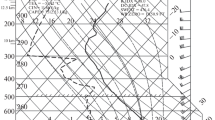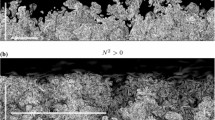Abstract
A one-dimensional hydrostatic and incompressible numerical model based upon the ‘shallow water wave’ equations is developed and used to simulate surface outflows from convective storms. Axial symmetry is employed to simulate surface outflows from storms in non-shearing environments, while slab symmetry is used to simulate unidirectional convective outflows.
The model is initialized with observed data from GATE and is found to be capable of simulating the slope, depth, overall shape, and propagation speed of the outflow of tropical squall-lines.
The model is used to construct a series of nomograms relating the depth of the head of the gust front to the origin and strength of the downdraft for various density differences and downdraft radii. The model predicts that convection which generates wide downdrafts originating deep within cumulonimbi and growing in strongly sheared environments (encouraging unidirectional outflows at the surface) produces the deepest gust fronts. To maintain these outflows requires the weakest downdraft velocities; when the downdrafts cease, such outflows do not decay rapidly. Conversely, the model predicts that narrow downdrafts originating near cloud base and growing in environments which encourage radial outflows, produce the shallowest gust fronts. To maintain radial outflows requires the strongest downdrafts; when the downdrafts cease, radial outflows decay most rapidly.
Similar content being viewed by others
References
Addis, R. P.: 1983, ‘Surface Outflows from Convective Storms’, Ph.D Dissertation at the University of Virginia.
Addis, R. P., Garstang, M., and Emmitt, G. D.: 1984, ‘Downdrafts from Tropical Oceanic Cumuli’, in Boundary-Layer Meteorol. 28, 23–49.
Barnes, G. M. and Garstang, M.: 1982, ‘Subcloud Layer Energetics of Precipitating Convection’, Monthly Weather Rev. 110, 102–117.
Benjamin, J. B.: 1968, ‘Gravity Currents and Related Phenomena’, J. Fluid Mech. 31, 209–248.
Betts, A. K.: 1976, ‘The Thermodynamic Transformation of the Tropical Subcloud Layer by Precipitation and Downdrafts’, J. Atmos. Sci. 33, 1008–1020.
Black, P. G.: 1978, ‘Mesoscale Cloud Patterns Revealed by ASTP Photographs’, Bull. Amer. Meteorol. Soc. 59, 1409–1419.
Brandli, H. W. and Orndorff, J. W.: 1976, ‘Satellite Viewed Cloud Lines, Anomalous or Others’, Monthly Weather Rev. 104, 210–213.
Browning, K. A. and Ludlam, F. H.: 1962, ‘Airflow in Connective Storms’, Quart. J. Roy. Meteorol. Soc. 88, 117–135.
Businger, J. A. and Seguin, W.: 1977, ‘Sea-Air Surface Fluxes of Latent and Sensible Heat and Momentum’, in Rept. of the U.S. GATE Central Program Workshop, Boulder, Colorado.
Byers, H. R. and Braham, R. R.: 1949, The Thunderstorm, Government Printing Office, Washington D.C.
Charba, J.: 1972, ‘Gravity Current Model Applied to Analysis of Squall-Line Gust Front’, NOAA TM ERL NSSLM-61.
Charba, J.: 1974, ‘Application of Gravity Current Model to Analysis of Squall-Line Gust Front’, Monthly Weather Rev. 102, 140–156.
Cooper, H. J., Garstang, M., and Simpson, J.: 1982, ‘The Diurnal Interaction between Convection and Peninsular Scale’, Monthly Weather Rev. 110, 486–503.
Emmitt, G. D.: 1978, ‘Tropical Cumulus Interaction with and Modification of the Subcloud Layer’, J. Atmos. Sci. 35, 1485–1502.
Fitzjarrald, D. R. and Garstang, M.: 1981, ‘Vertical Structure of the Tropical Boundary Layer’, Monthly Weather Rev. 109, 1512–1526.
Fujita, T.: 1963, ‘Analytical Mesometeorology: A Review’, Severe Local Storms, Meteorol. Monogr., No. 27, Amer. Meteorol. Soc.
Goff, R. C.: 1976, ‘Vertical Structure of Thunderstorm Outflows’, Monthly Weather Rev. 104, 1429–1440.
Holle, R. L. and Maier, M. W.: 1980, ‘Tornado Formation from Downdraft Interaction in the FACE Mesonetwork’, Monthly Weather Rev. 108, 1010–1028.
Houze, R. A. Jr.: 1977, ‘Structure and Dynamics of a Tropical Squall-Line System’, Monthly Weather Rev. 105, 1540–1567.
Keulegan, G. H.: 1957, ‘An Experimental Study of the Motion of Saline Water Locks into Fresh Water Channel’, U.S. Nat. Bur. Stand. Rep. No. 5168.
Keulegan, G. H.: 1958, ‘The Motion of Saline Fronts in Still Water’, U.S. Nat. Bur. Stand. Rep. No. 5831, 28 pp.
Leary, C. A. and Houze, R. A.: 1979, ‘The Structure and Evolution of Convection in a Tropical Cloud Cluster’, J. Appl. Meteorol. 365, 437–456.
Middleton, G. V.: 1966, ‘Experiments on Density and Turbidity Currents. I. Motion of the Head’, Canadian J. Earth Sci. 3, 523–546.
Mitchell, K. E. and Hovermale, J. B.: 1977, ‘A Numerical Investigation of the Severe Thunderstorm Gust Front’, Monthly Weather Rev. 105, 657–675.
Purdom, J. F. W.: 1972, ‘Picture of the Month — Meso-Highs and Satellite Imagery’, Monthly Weather Rev. 101, 180–181.
Ray, P. S.: 1976, ‘Vorticity and Divergence Fields within Tornadic Storms from Dual-Doppler Observations’, J. Appl. Meteorol. 15, 879–890.
Seguin, W. R. and Garstang, M.: 1976, ‘Some Evidence of the Effects of Convection on the Structure of the Tropical Subcloud Layer’, J. Atmos. Sci. 33, 660–666.
Seguin, W. R., Sabol, P., Crayton, R., Cram, R. S., Echternacht, K. L., and Poindexter, M.: 1977, ‘U.S. National Processing Center for GATE: B-scale Surface Meteorological and Radiation System, Including Instrumentation, Processing, and Archived Data’, NOAA Tech. Kept. EDS - 22 (NTIS publication PB -268-816).
Simpson, J. E.: 1969, ‘A Comparison between Laboratory and Atmospheric Density Currents’, Quart. J. Roy. Meteorol. Soc. 95, 758–768.
Simpson, J. E.: 1972, ‘Effects of the Lower Boundary on the Head of a Gravity Current’, J. Fluid Mech. 53, 759–768.
Simpson, J. E. and Britter, R. E.: 1980, ‘A Laboratory Model of an Atmospheric Mesofront’, Quart. J. Roy. Meteorol. Soc. 106, 485–500.
Simpson, J. E., Mansfield, D. A., and Milford, J. R.: 1977, ‘Inland Penetration of Sea-Breeze Fronts’, Quart. J. Roy. Meteorol. Soc. 103, 47–76.
Sinclair, R. W., Anthes, R. A., and Panofsky, H. A.: 1973, ‘Variation of the Low Level Winds During the Passage of a Thunderstorm Gust Front’, NASA Cont. Rept., NASA CR-2289.
Ulanski, S. L. and Garstang, M.: 1978, ‘The Role of Surface Divergence and Vorticity in the Life Cycle of Convective Rainfall. Part I: Observation and Analysis’, J. Atmos. Sci. 35, 1047–1062.
Von Karman, T.: 1940, ‘The Engineer Grapples with Nonlinear Problems’, Bull. Amer. Meteorol. Soc. 46, 615–683.
Wakimoto, R. M.: 1982, ‘The Life Cycle of Thunderstorm Gust Fronts as Viewed with Doppler Radar and Rawinsonde Data’, Monthly Weather Rev. 110, 1060–1082.
Wood, I. R.: 1965, ‘Studies in Unsteady Self-Preserving Turbulent Flows’, Univ. N.S.W., Australia. Report No. 81, 152 pp.
Wylie, D. P. and Ropelewski, C. F.: 1980, ‘The GATE Boundary-Layer Instrumentation System (BLIS)’, Bull. Amer. Meteorol. Soc. 61, 1002–1011.
Zeman, O.: 1982, ‘The Dynamics and Modelling of Heavier-Than-Air, Cold Gas Releases’, Atmos. Envir. 16, 741–751.
Zipser, E. J.: 1977, ‘Mesoscale and Convective Scale Downdrafts as Distinct Components of Squall-Line Structure’, Monthly Weather Rev. 105, 1568–1589.
Author information
Authors and Affiliations
Rights and permissions
About this article
Cite this article
Addis, R.P. A numerical model of surface outflows from convective storms. Boundary-Layer Meteorol 28, 121–160 (1984). https://doi.org/10.1007/BF00119460
Accepted:
Issue Date:
DOI: https://doi.org/10.1007/BF00119460




